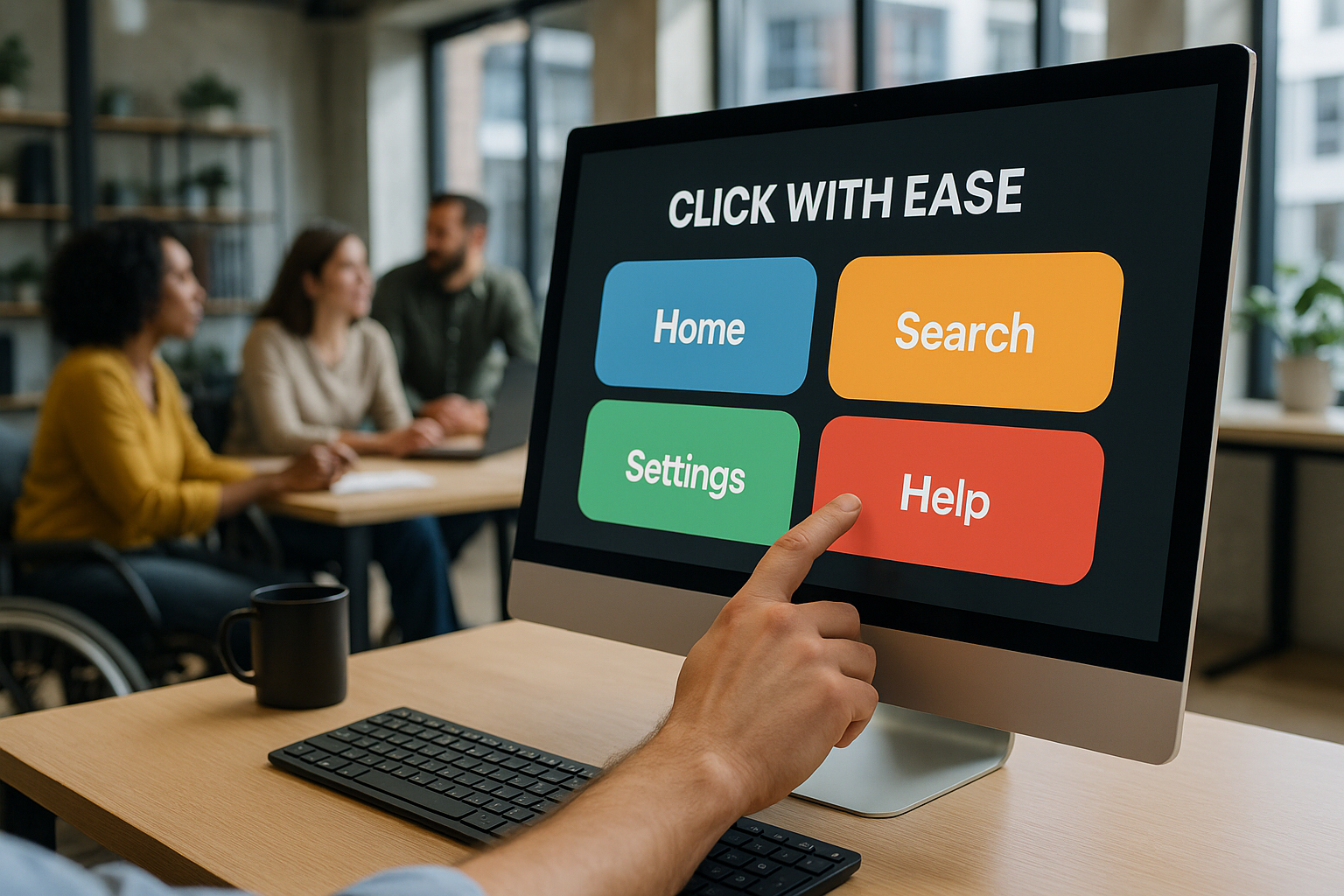It’s the golden thread that binds the elements of a website or an application together, making it an enjoyable, and most importantly, a functional space for users of all abilities. 💡
While elements like typography, color schemes, and navigation menus are crucial, one of the most basic yet fundamental elements often overlooked is the humble button. Yes, those tiny clickable elements scattered across your screen, tasked with carrying out various functions from submitting a form to playing a video or redirecting you to a new page.
In today’s discourse, we delve deep into the topic of ‘Click with Ease: Enhancing User Experience with Accessible Buttons for All Abilities.’ Whether you are a seasoned developer, an aspiring UX designer, or a curious reader with a penchant for technology, this comprehensive guide will serve as a valuable resource. It aims to navigate the intricacies of creating accessible buttons, which not only enhance the overall user experience but also empower users of all abilities. 👩💻👨💻
What lies ahead?
As we journey through this exploration of accessible buttons, we will first shed light on the importance of accessibility in UX design, particularly focusing on button design. Here, you will learn why accessibility matters, its impact on user experience, and how it aligns with the principles of inclusive design. This section will lay the groundwork for understanding the profound implications of a simple click! 🖱️
Moving forward, we will discuss the common pitfalls and challenges faced in designing accessible buttons. This segment will not only highlight the prevalent issues but will also touch upon the importance of semantic HTML in creating accessible buttons. By understanding these challenges, you can avoid common mistakes, thus paving the way for enhanced user experience and accessibility. 🚧
Having gained insight into the challenges, we will then embark on a practical journey, exploring the best practices for creating accessible buttons. We will delve into topics such as button hierarchy, color contrast, size, and placement, among others. This section will provide you with actionable strategies and tips to implement in your design process, ultimately leading to more accessible and user-friendly buttons. 🎨
Lastly, we will conclude with a discussion on the role of testing in ensuring button accessibility. Here, you will learn about the different testing methods and tools available, and how they can be leveraged to validate the accessibility of your buttons. This final section aims to reinforce the importance of ongoing testing and iterative design in achieving optimal accessibility. 🔎
In a world where digital accessibility is more important than ever, understanding and implementing accessible button design can make a significant difference. This guide promises to provide you with the knowledge and tools to take your UX design to the next level. So, buckle up and get ready to ‘click with ease’! 🚀
Unraveling the Science of User Experience: Understanding Accessible Buttons
Technology has revolutionized our way of living and interacting with the world. It is a colossal landscape, and one aspect that stands paramount is User Experience (UX). This blog post will delve deep into one such critical element of UX – accessible buttons. As we proceed, we’ll explore how making buttons accessible for all abilities can enhance the overall user experience. We’ll also uncover various strategies and tools that can help you achieve this. So, let’s dive in! 🚀
Understanding the importance of accessibility in digital platforms is paramount. With millions of people worldwide having some form of disability, it is vital to ensure that the technology we build is accessible to all. This is where accessible buttons come into play. They are designed in a way to be easily perceived, understood, and used by individuals with varying abilities.
Creating accessible buttons is not just about compliance with guidelines, but it’s also about improving the overall user experience. Accessible buttons ensure that all users, irrespective of their abilities, can interact with the digital platform with ease. This leads to enhanced user satisfaction, increased user engagement, and improved brand reputation.
Why are Accessible Buttons Crucial?
Buttons are an essential element of any digital interface, from websites to mobile applications. They guide users through the platform, helping them perform various tasks such as submitting forms, initiating downloads, or navigating through different pages. Inaccessible buttons can hamper the usability of the platform, making it difficult for users to interact and complete their tasks.
Accessible buttons, on the other hand, can significantly enhance the user experience. They are designed considering the various needs and abilities of users. They have clear labels, are easy to identify and use, and provide appropriate feedback when interacted with. They ensure that users with disabilities can access and interact with the platform, providing an inclusive digital experience.
Creating accessible buttons is not only beneficial for users with disabilities, but it also improves the overall usability of the platform. It leads to a better design, smoother navigation, and increased user satisfaction. Therefore, it is crucial for businesses and developers to prioritize creating accessible buttons when designing their digital platforms.
A Deep Dive into Creating Accessible Buttons
Now that we understand the importance of accessible buttons let’s delve into how to create them. There are several factors to consider when designing accessible buttons, including size, color, contrast, labeling, and feedback. We will look at each of these factors in detail and understand how they contribute to making buttons accessible.
Size Matters: Creating Buttons that are Easy to Click
The size of the button is a critical factor in its accessibility. It should be large enough to be easily clicked or tapped, but not so large that it distracts from the overall design. According to the Apple Human Interface Guidelines, a button should have a minimum target area of 44×44 pixels. This ensures that the button is easy to interact with, irrespective of the user’s motor skills.
It’s also important to maintain appropriate spacing between buttons to prevent accidental clicks. A user should be able to click a button without inadvertently interacting with another element on the page. This is especially important for users with motor disabilities who may find precise clicking or tapping challenging.
Seeing Clearly: Importance of Color and Contrast
Color and contrast play a crucial role in making buttons easily identifiable. Buttons should stand out from the background, making it easy for users to locate them. A high contrast ratio between the button color and the background color can help achieve this.
It’s also essential to consider color blindness when designing buttons. Using color combinations that are distinguishable to users with color vision deficiencies can make your buttons more accessible. Tools like the Color Contrast Analyzer can help you check the contrast ratio and simulate how your colors would appear to a color-blind user.
Accessible Buttons in Action: Comparative Analysis and Real-life Examples
To illustrate the principles discussed above, let’s compare and contrast some real-life examples of accessible and inaccessible buttons.
| Inaccessible Button | Accessible Button |
|---|---|
| Small size, low contrast, vague labeling | Large size, high contrast, clear labeling |
| Buttons placed close together, causing accidental clicks | Appropriate spacing between buttons, preventing accidental clicks |
| Colors not distinguishable for color-blind users | Colors distinguishable for color-blind users |
Take a moment to check out this YouTube video titled “Creating Accessible Web Buttons: A Comprehensive Guide” by Developer Academy. It provides a step-by-step guide on creating accessible web buttons, emphasizing the principles we’ve discussed in this blog post.
Tools and Resources for Creating Accessible Buttons
Thankfully, there are numerous tools and resources available that can assist in creating accessible buttons. These tools can help you ensure that your buttons are compliant with accessibility guidelines and provide an enhanced user experience.
Accessibility Evaluation Tools
These tools help evaluate the accessibility of your buttons and provide recommendations for improvement. Examples include WAVE (Web Accessibility Evaluation Tool), AChecker, and Google’s Lighthouse. These tools can be a great starting point in your journey towards creating accessible buttons.
Button Generator Tools
Button generator tools allow you to create custom buttons with various accessibility features. Some popular button generator tools include Da Button Factory, Button X, and Button Builder. These tools provide options for adjusting size, color, contrast, and labeling to create accessible buttons.
Learning Resources
There are numerous resources available that can help you learn more about accessible buttons and how to create them. Resources like the Web Content Accessibility Guidelines (WCAG), the A11Y Project, and various online courses provide detailed guidelines and best practices for creating accessible buttons.
Final Thoughts: Embracing Inclusivity in UX Design
The importance of accessible buttons in enhancing user experience cannot be overstated. They make digital platforms accessible to all users, irrespective of their abilities, and contribute to a more inclusive digital world. By understanding the principles of accessible buttons and using the available tools and resources, we can create digital platforms that are truly inclusive and user-friendly.
So, let’s embrace the principles of accessible design, make our buttons accessible, and create a better and more inclusive digital experience for all. Because everyone deserves to click with ease. 👏

Conclusion
In conclusion, it is evident that the evolving world of technology is an essential part of our lives today. It’s as integral to our routines as eating and sleeping. This article has thoroughly examined the core aspects of the IT and Engineering fields, demonstrating the immense importance of these areas in the present and future technological era.
We commenced by dissecting the concept of Software Engineering, showcasing how it drives the development of intricate applications and systems we interact with daily. From the designing phase to testing and maintenance, software engineering principles are paramount in ensuring these applications meet users’ needs and are user-friendly.
In addition, we shed light on the field of IT, explaining its relevance in managing and processing information. This field is the backbone of businesses, governments, and even our personal lives. We illustrated how IT professionals ensure systems run smoothly, data is secure, and networks are reliable.
In furthering our understanding, we also discussed some advanced topics. Machine Learning and Artificial Intelligence (AI), the rising stars of the technology world, were given a spotlight. From self-driving cars to voice assistants, we are living in an era where machines can learn and make decisions. It’s no exaggeration to say that these fields are and will continue to revolutionize how we live, work, and interact.
Lastly, we ventured into the world of Cybersecurity, a field that has gained tremendous attention due to the increasing cyber threats that come with the digital age. We underscored the crucial role cybersecurity plays in protecting our personal and financial information, as well as sensitive data in organizations.
In sum, the technological world is a vast and complex landscape, yet this article has successfully broken down some of its key elements in a comprehensible manner. The importance of fields like Software Engineering, IT, AI, Machine Learning, and Cybersecurity cannot be overstated. They are the pillars that uphold our digital society and the catalysts propelling us into an exciting, high-tech future.🚀
With this newfound knowledge, I encourage you to dive deeper into these subjects. Perhaps you might even consider a career in one of these exciting fields. If you found this article insightful, please feel free to share it with your friends and colleagues.🌐 And if you have any questions or would like to discuss further, don’t hesitate to leave a comment below.💬
Don’t stop learning. The future is in your hands.👐
References:
- What is Programming?
- What is IT Management?
- What is Machine Learning?
- Artificial Intelligence Explained
- What is Cybersecurity?
Let’s keep the conversation going! 🙌



